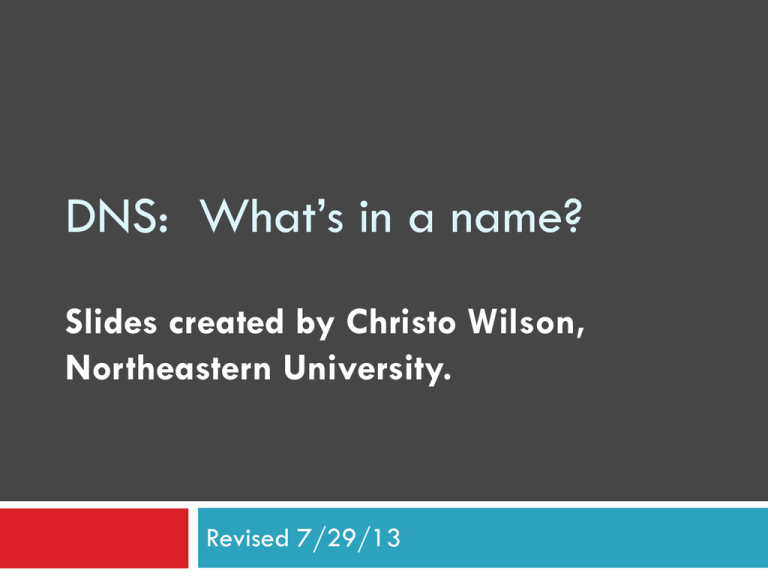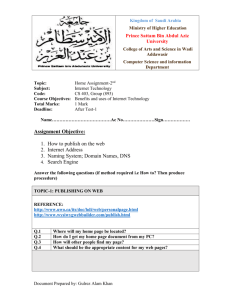DNS: What’s in a name? Slides created by Christo Wilson,
advertisement

DNS: What’s in a name? Slides created by Christo Wilson, Northeastern University. Revised 7/29/13 Human Involvement 2 If you want to… Call someone, you need to ask for their phone number You Mail can’t just dial “P R O F W I L S O N” someone, you need to get their address first What about the Internet? If you need to reach Google, you need their IP Does anyone know Google’s IP? Problem: People can’t remember IP addresses Need human readable names that map to IPs Internet Names and Addresses 3 Addresses, e.g. 129.10.117.100 Computer usable labels for machines Conform to structure of the network Names, e.g. www.northeastern.edu Human usable labels for machines Conform to organizational structure How do you map from one to the other? Domain Name System (DNS) History 4 Before DNS, all mappings were in hosts.txt /etc/hosts on Linux C:\Windows\System32\drivers\etc\hosts on Windows Centralized, manual system Changes were submitted to SRI via email Machines periodically FTP new copies of hosts.txt Administrators could pick names at their discretion Any name was allowed christos_server_at_neu_pwns_joo_lol_kthxbye Towards DNS 5 Eventually, the hosts.txt system fell apart Not scalable, SRI couldn’t handle the load Hard to enforce uniqueness of names e.g MIT Massachusetts Institute of Technology? Melbourne Institute of Technology? Many machines had inaccurate copies of hosts.txt Thus, DNS was born 6 Outline DNS Basics DNS Security DNS at a High-Level 7 Domain Name System Distributed database No centralization Simple client/server architecture UDP port 53, some implementations also use TCP Hierarchical namespace As opposed to original, flat namespace e.g. .com google.com mail.google.com Naming Hierarchy 8 Root net edu com gov neu mit ccs ece husky mil org uk fr etc. Top Level Domains (TLDs) are at the top Maximum tree depth: 128 Each Domain Name is a subtree neu.edu ccs.neu.edu www.ccs.neu.edu .edu www login mail Name collisions are avoided neu.com vs. neu.edu Hierarchical Administration 9 Root Verisign net edu com gov neu mit uk fr Tree is divided into zones zone has an administrator Responsible for the part of the heirarchy Example: CCIS login org Each ccs www mil ICANN mail controls *.ccs.neu.edu NEU controls *.neu.edu etc. Server Hierarchy 10 Functions of each DNS server: Authority No need to store all DNS names Store all the records for hosts/domains in its zone May Know be replicated for robustness the addresses of the root servers Resolve over a portion of the hierarchy queries for unknown names Root servers know about all TLDs The buck stops at the root servers Root Name Servers 11 Responsible for the Root Zone File com. com. com. 172800 IN 172800 IN 172800 IN NS NS NS a.gtld-servers.net. b.gtld-servers.net. c.gtld-servers.net. Administered by ICANN Lists the TLDs and who controls them ~272KB in size 13 root servers, labeled AM 6 are anycasted, i.e. they are globally replicated Contacted when names cannot be resolved In practice, most systems cache this information Map of the Roots 12 Local Name Servers 13 Where is google.com? Northeastern Each ISP/company has a local, default name server Often configured via DHCP Hosts begin DNS queries by contacting the local name server Frequently cache query results Authoritative Name Servers 14 Where is www.neu.edu? www.neu.edu = 155.33.17.68 www.neu.edu Northeastern Root edu Authority for ‘edu’ neu Authority for ‘neu.edu’ Stores the nameIP mapping for a given host Basic Domain Name Resolution 15 Every host knows a local DNS server Sends all queries to the local DNS server If the local DNS can answer the query, then you’re done Local server is also the authoritative server for that name Local server has cached the record for that name 1. 2. Otherwise, go down the hierarchy and search for the authoritative name server Every local DNS server knows the root servers Use cache to skip steps if possible e.g. skip the root and go directly to .edu if the root file is cached Recursive DNS Query 16 www.google.com Where is www.google.com? Puts the burden of resolution on the contacted name server How does asgard know who to forward responses too? Random IDs embedded in DNS asgard.ccs.neu.edu queries ns1.google.com What have we said about keeping state in the network? com Root Iterated DNS query 17 www.google.com Where is www.google.com? Contact server replies with the name of the next authority in the hierarchy “I don’t know this name, butasgard.ccs.neu.edu this other server might” This is how DNS works today ns1.google.com com Root DNS Propagation 18 How many of you have purchased a domain name? Did you notice that it took ~72 hours for your name to become accessible? This delay is called DNS Propagation www.my-new-site.com Root asgard.ccs.neu.edu com ns.godaddy.com Why would this process fail for a new DNS name? Caching vs. Freshness 19 DNS Propagation delay is caused by caching Where is That name does www.my-new-site.com?not exist. • • • • Cached Root Zone File Cached .com Zone File Cached .net Zone File Etc. asgard.ccs.neu.edu Zone files may be cached for 1-72 hours Root www.my-new-site.com com ns.godaddy.com DNS Resource Records 20 DNS queries have two fields: name and type Resource record is the response to a query Four fields: (name, value, type, TTL) There may be multiple records returned for one query What do the name and value mean? Depends on the type of query and response DNS Types = domain name Value = IP address A is IPv4, AAAA is IPv6 Query Name Name: www.ccs.neu.edu Type: A Resp. Type = A / AAAA Name: www.ccs.neu.edu Value: 129.10.116.81 Query Name: ccs.neu.edu Type: NS Resp. 21 Name: ccs.neu.edu Value: 129.10.116.51 Type = NS Name = partial domain Value = name of DNS server for this domain “Go send your query to this other server” DNS Types, Continued = hostname Value = canonical hostname Useful for aliasing Query Name Name: foo.mysite.com Type: CNAME Resp. Type = CNAME Name: foo.mysite.com Value: bar.mysite.com Query Name: ccs.neu.edu Type: MX Resp. 22 Name: ccs.neu.edu Value: amber.ccs.neu.edu Type = MX Name = domain in email address Value = canonical name of mail server Reverse Lookups 23 Rooted at in-addr.arpa and ip6.arpa Additional DNS record type: PTR Name = IP address Value = domain name Query What about the IPname mapping? Separate server hierarchy stores reverse mappings Name: 129.10.116.51 Type: PTR Resp. Name: 129.10.116.51 Value: ccs.neu.edu DNS as Indirection Service 24 DNS gives us very powerful capabilities Not only easier for humans to reference machines! Changing the IPs of machines becomes trivial e.g. you want to move your web server to a new host Just change the DNS record! Aliasing and Load Balancing 25 One machine can have many aliases www.reddit.com www.foursquare.com www.huffingtonpost.com christo.blogspot.com sandi.blogspot.com *.blogspot.com One domain can map to multiple machines www.google.com Content Delivery Networks 26 DNS responses may vary based on geography, ISP, etc 27 Outline DNS Basics DNS Security The Importance of DNS 28 Without DNS… How could you get to any websites? You are your mailserver When you sign up for websites, you use your email address What if someone hijacks the DNS for your mail server? DNS is the root of trust for the web When a user types www.bankofamerica.com, they expect to be taken to their bank’s website What if the DNS record is compromised? Denial Of Service 29 Flood DNS servers with requests until they fail October 2002: massive DDoS against the root name servers What was the effect? … users didn’t even notice Root zone file is cached almost everywhere More targeted attacks can be effective DNS server cannot access DNS Authoritative server cannot access domain Local DNS Hijacking 30 Infect their OS or browser with a virus/trojan e.g. Many trojans change entries in /etc/hosts *.bankofamerica.com evilbank.com Man-in-the-middle Response Spoofing Eavesdrop on requests Outrace the servers response Where is DNSbankofamerica.com? Spoofing 31 123.45.67.89 How do you know that a given nameIP mapping is correct? dns.bofa.com Where is bankofamerica.com? 66.66.66.93 123.45.67.89 dns.evil.com 66.66.66.93 Where is DNSwww.google.com? Cache Poisoning Where is 32 bankofamerica.com? dns.neu.edu www.google.com = 74.125.131.26 ns1.google.com Until the TTL expires, all queries for BofA to bankofamerica.com = dns.neu.edu will return poisoned result 66.66.66.92 Much worse than spoofing/man-in-the-middle Whole ISPs can be impacted! Solution: DNSSEC 33 Cryptographically sign critical resource records Resolver can verify the cryptographic signature Two new resource types Type = DNSKEY Name = Zone domain name Value = Public key for the zone Creates a hierarchy of trust within eachhijacking zone Prevents and spoofing Type = RRSIG Name = (type, name) tuple, i.e. the query itself Value = Cryptographic signature of the query results Deployment On the roots since July 2010 Verisign enabled it on .com and .net in January 2011 Comcast is the first major ISP to support it (January 2012) DNSSEC Hierarchy of Trust 34 Root Zone (ICANN) .com (Verisign) Where is bankofamerica.com? IP: IP:123.45.67.89 66.66.66.93 Key: < > SIG: SIG:9na8x7040a3 x9fnskflkalk dns.bofa.com dns.evil.com Site Finder 35 September 2003: Verisign created DNS wildcards for *.com and *.net Essentially, catch-all records for unknown domains Pointed to a search website run by Verisign Search website was full of advertisements Extremely controversial move Is this DNS hijacking? Definitely abuse of trust by Verisign Site Finder was quickly shut down, lawsuits ensued Much More to DNS 36 Caching: when, where, how much, etc. Other uses for DNS (i.e. DNS hacks) Content Delivery Networks (CDNs) Different types of DNS load balancing Dynamic DNS (e.g. for mobile hosts) DNS and botnets Politics and growth of the DNS system Governance New TLDs (.xxx, .biz), eliminating TLDs altogether Copyright, arbitration, squatting, typo-squatting




